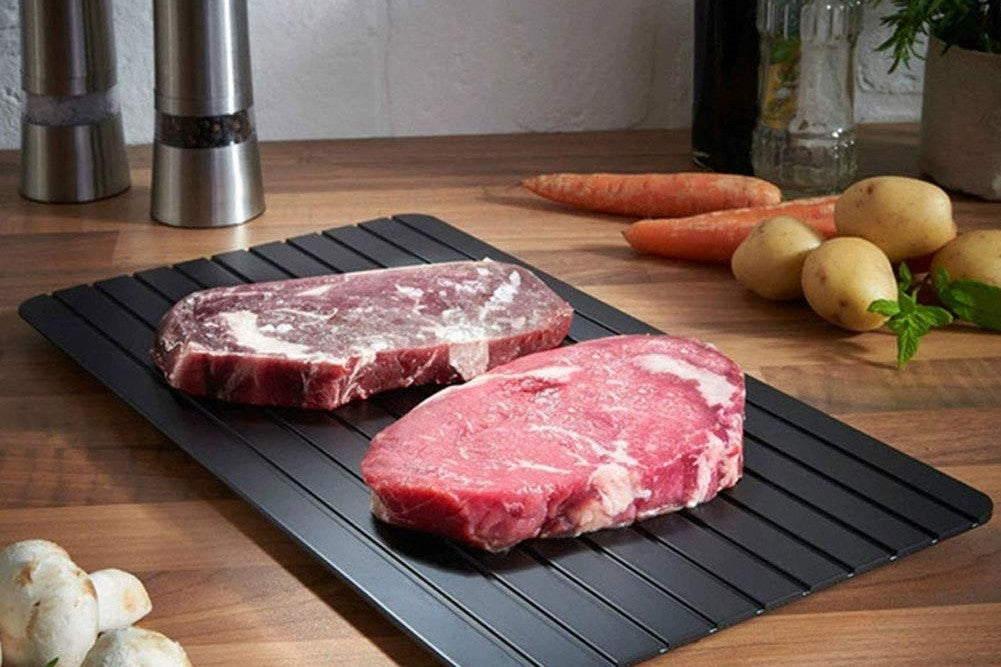
The Importance of Properly Thawing Frozen Meat & How to Do It Safely
Share
The Importance of Properly Thawing Frozen Meat and How to Do It Safely
When it comes to preparing a delicious meal, how you thaw your frozen meat might seem like a minor detail, but it’s actually a critical step for food safety and quality. Improper thawing methods can lead to uneven defrosting, texture loss, and even dangerous bacteria growth. Let's dive into why proper thawing is essential, the risks of common methods, and why a Food Defrosting Tray is the best solution for safe, efficient defrosting.
The Risks of Improperly Thawing Meat
Many people use convenient but unsafe methods to thaw their frozen meat. Here are the most common methods—and why they’re problematic:
-
Leaving Meat on the Counter:
Leaving meat out at room temperature for hours is a popular method, but it’s a risky one. When meat sits between 40°F and 140°F (the "danger zone"), bacteria like Salmonella and E. coli can multiply rapidly, making the meat unsafe to eat. -
Using Hot Water:
Placing frozen meat in hot water might seem like a quick fix, but it causes uneven thawing. The outer layer of the meat may begin to cook while the inside remains frozen. This not only compromises food safety but can also affect the texture and taste of the meat. -
Microwave Defrosting:
The defrost function on a microwave often partially cooks the meat in spots while leaving other areas frozen. This uneven heating can lead to food safety issues and a less-than-ideal cooking experience.
The Proper Way to Thaw Meat
The best way to thaw meat safely and efficiently is by using a Food Defrosting Tray, a tool specifically designed to speed up the defrosting process without compromising food safety or quality. Here's why this innovative method outshines traditional techniques:
1. High-Quality Aluminum for Fast Thawing
Food defrosting trays are made from high-quality aluminum, a material known for its excellent heat conduction. It naturally draws heat from the surrounding environment, rapidly and evenly defrosting your meat without the need for electricity, hot water, or prolonged exposure to room temperature.
2. Non-Stick Surface for Easy Handling
The non-stick surface ensures that your food doesn’t stick to the tray, making it easy to handle and hassle-free to clean. Say goodbye to messy thawing experiences!
3. Preserves Food Quality
Unlike microwaves or hot water methods that partially cook or ruin the texture of your meat, a defrosting tray preserves the original quality. Your meat stays tender, juicy, and ready for perfect cooking.
4. Versatile for Different Foods
Whether it’s beef, poultry, fish, or even delicate seafood, a food defrosting tray works efficiently for all types of frozen foods, saving you time and effort in the kitchen.
How to Use a Food Defrosting Tray
- Place the frozen meat directly onto the tray.
- Let it sit at room temperature. The tray’s natural heat-conducting properties will quickly and safely thaw the food.
- Flip the meat halfway through the process to ensure even defrosting.
- Rinse the tray under warm water for easy cleanup.
With this method, you’ll have your meat thawed and ready to cook in no time—without sacrificing safety or quality.
Why It Matters
Proper thawing is about more than just convenience. It’s about ensuring your food is safe to eat, preserving the texture and flavor, and setting yourself up for a successful cooking experience. A Food Defrosting Tray is an investment in both safety and quality, helping busy home cooks defrost meat the right way while simplifying their kitchen routine.
With this tool in your arsenal, you can ditch unsafe methods and embrace a safer, smarter approach to meal prep. Bon appétit!
